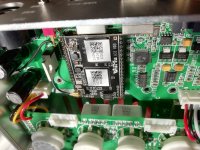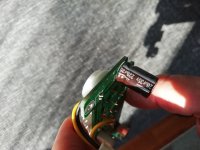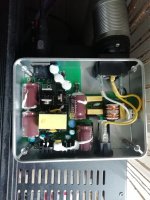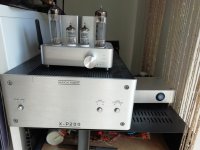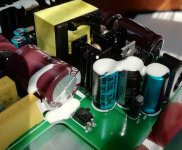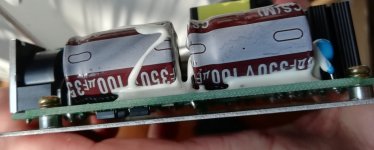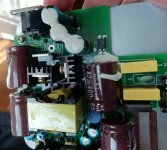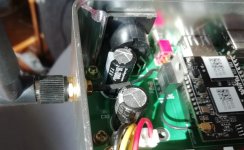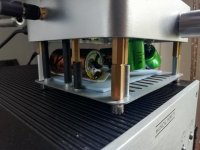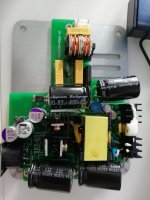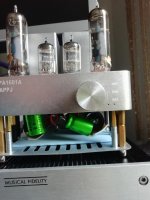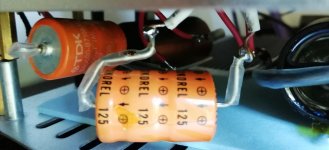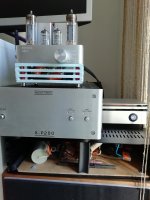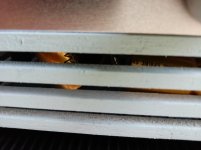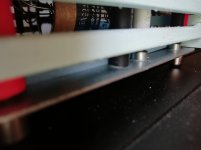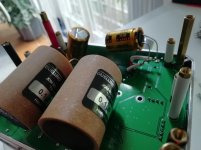After ruining my Miniwatt N3 amp well, I was excited by the experience it gave me while I was listening rather than soldering, well based on that I felt the urge to get a similar one. At the time, N3 was not for sale, and I had already purchased excellent TUNGSRAM pieces from EL84, so the APPJ 1601A, which also uses EL84 power valves, came in handy.
What he says, I also love the new composition.
All I know about it is that like the N3, in principle, it is also an ultra linear SE amplifier. But how about SET or SEP? Maybe it doesn't matter.
It sounds great, I like that it consists of two units, and of course I'm not resting, I had to look at what's going on in the field of capacitors. There are one or two "suspicious" pieces, e.g. the 16V 1500 uF Rubycon RX30, which speciel I can't find in a vendor, but not even in the brochures.
I also don't understand the need for a 4.7uF 400V capacitor "400V" with the Rubycon YXG 16V 1000uF.
What he says, I also love the new composition.
All I know about it is that like the N3, in principle, it is also an ultra linear SE amplifier. But how about SET or SEP? Maybe it doesn't matter.
It sounds great, I like that it consists of two units, and of course I'm not resting, I had to look at what's going on in the field of capacitors. There are one or two "suspicious" pieces, e.g. the 16V 1500 uF Rubycon RX30, which speciel I can't find in a vendor, but not even in the brochures.
I also don't understand the need for a 4.7uF 400V capacitor "400V" with the Rubycon YXG 16V 1000uF.
I replaced the 220uF 35V bypass capacitors with a Panasonic FP 510uF 35V. The Evox MMK 0.15uF coupling capacitors are currently replaced by Mundorf Evo Oil 0.1 uF + russian FT1 0.001uF Teflon bypass capacitor,
as they were on hand.
Does anyone have experience with OSCON-type capacitors as a bypass capacitor instead of the current 510uF? I only found a 1000uF 25V hybrid-polymer capacitor, but the 25V already feels low.
as they were on hand.
Does anyone have experience with OSCON-type capacitors as a bypass capacitor instead of the current 510uF? I only found a 1000uF 25V hybrid-polymer capacitor, but the 25V already feels low.
Just today arrived the new capacitors, and I have to use some standoff because of the larger size of cathode bypass capacitors and Audyn TCM 0.22 uF coupling capacitors, but these standoffs does not arrived yet.
First I am going to replace the caps at power unit ( it is the another box with power button).
First I am going to replace the caps at power unit ( it is the another box with power button).
Hello kouiky,
Before APPJ1601 I had (have) a Miniwatt N3. When I replaced a capacitor, something popped up in it, and even though I replaced almost everything in it, it doesn't make any sound. On the other hand, I also fell in love with the sound of the N3 so much so that I had to get this also nice little tube amp.
In the power supply, all capacitors were replaced (where possible, there with hyprid polymer), and in the other unit, both capacitors were replaced with new ones.
And since I obviously didn't stop here, and sacrificing its tiny shape so far, it has already received spacers for which a kind of wooden "frame" is already planned, as well as a frame made with a 3D printer as an option.
And the spacers are necessary because the coupling and cathode bypass capacitor sections have been "redesigned" a bit, so at least from the bottom I can easily access and change them if I feel like it. Plus fits like "fat sized" Audyn True Copper Max 0.22uF to replace the coupling capacitor.
Too many capacitors were replaced almost at once to highlight a single component, but its voice changed to my taste and happy.
Suddenly, I could highlight one thing: I tried quite a few capacitors in the coupling position. When the Panasonic ECWFE was 0.47uF inside (instead of the factory 0.12uF Evox), I had a brief feeling about its sound: a lot of detail, very clear, but on that basis I could even listen to my SS amplifier. It was the fineness of the tube that disappeared from the system.
The measured value was 9-10V in the cathode bypass position, so I inserted the 25V bipolar Muse capacitors with a calm heart, and together with Audyn they form a great pair even now.
So in answer to your question: there is no way to perform ESR measurements or various analyzes unfortunately in the absence of serious instruments, but this little "bastard" plays so well that the Musical Fidelity X-P200 has been left without power for months ...
Before APPJ1601 I had (have) a Miniwatt N3. When I replaced a capacitor, something popped up in it, and even though I replaced almost everything in it, it doesn't make any sound. On the other hand, I also fell in love with the sound of the N3 so much so that I had to get this also nice little tube amp.
In the power supply, all capacitors were replaced (where possible, there with hyprid polymer), and in the other unit, both capacitors were replaced with new ones.
And since I obviously didn't stop here, and sacrificing its tiny shape so far, it has already received spacers for which a kind of wooden "frame" is already planned, as well as a frame made with a 3D printer as an option.
And the spacers are necessary because the coupling and cathode bypass capacitor sections have been "redesigned" a bit, so at least from the bottom I can easily access and change them if I feel like it. Plus fits like "fat sized" Audyn True Copper Max 0.22uF to replace the coupling capacitor.
Too many capacitors were replaced almost at once to highlight a single component, but its voice changed to my taste and happy.
Suddenly, I could highlight one thing: I tried quite a few capacitors in the coupling position. When the Panasonic ECWFE was 0.47uF inside (instead of the factory 0.12uF Evox), I had a brief feeling about its sound: a lot of detail, very clear, but on that basis I could even listen to my SS amplifier. It was the fineness of the tube that disappeared from the system.
The measured value was 9-10V in the cathode bypass position, so I inserted the 25V bipolar Muse capacitors with a calm heart, and together with Audyn they form a great pair even now.
So in answer to your question: there is no way to perform ESR measurements or various analyzes unfortunately in the absence of serious instruments, but this little "bastard" plays so well that the Musical Fidelity X-P200 has been left without power for months ...
Attachments
Is the APPJ 1601A the same circuit and component values as the N3? I understand the S1 and N3 Miniwatt amps were built by APPJ.
Regarding your N3, I would check the power supply with a digital multimeter to see if it was supplying appropriate voltages to the anodes and heaters. The tubes won’t work without them.
Regarding your N3, I would check the power supply with a digital multimeter to see if it was supplying appropriate voltages to the anodes and heaters. The tubes won’t work without them.
Here is my N3 story.
Miniwatt N3 not turning on!
Since then, I’ve found and repaired the source of the hiss with a replacement: it wasn’t the smps, it was the black inductor that sparkled and it had that kind of sound.
At the moment I am holding that the tubes are lit, there is still voltage in the filter capacitors, but from there I cannot measure voltage at either the anode, cathode bypass caps or coupling caps.
The N3 and 1601 are similar, but they still have differences. The fact that the N3 had 3 filter capacitors, here are two 100uF is just one difference.
N3 has one main capacitor with 120uF, here are two with 2x82 uF.
But more spectacularly, the N3 has 1-1 pieces of IRF840 mosfets around the cathode capacitors. In 1601 there are none.
Miniwatt N3 not turning on!
Since then, I’ve found and repaired the source of the hiss with a replacement: it wasn’t the smps, it was the black inductor that sparkled and it had that kind of sound.
At the moment I am holding that the tubes are lit, there is still voltage in the filter capacitors, but from there I cannot measure voltage at either the anode, cathode bypass caps or coupling caps.
The N3 and 1601 are similar, but they still have differences. The fact that the N3 had 3 filter capacitors, here are two 100uF is just one difference.
N3 has one main capacitor with 120uF, here are two with 2x82 uF.
But more spectacularly, the N3 has 1-1 pieces of IRF840 mosfets around the cathode capacitors. In 1601 there are none.
Today, the MUSE NP will be replaced by the TDK B40600 Hybrid Polymer Alu capacitor, which was originally soldered after the conversion.
I know I compare apples to pears, but I still hear what I hear from that. The MUSE NP had 470uF capacity, the TDK set hybrid alu, polarized and 1000 uF capacity.
I can only tell you that it is an excellent sounding capacitor in the cathode bypass position. Compared to MUSE, it is a slightly, but audibly more spacious, airy space. And more audible noises. Which might even sound bad, but I mean things like the squeaking of vinyl during quiet breaks. The goods add almost the same taste and sound to the system. For me, TDK is currently my favourite.
I wonder how Audio Note Kaisei (470uF 25V) will sound compared to this TDK.
I know I compare apples to pears, but I still hear what I hear from that. The MUSE NP had 470uF capacity, the TDK set hybrid alu, polarized and 1000 uF capacity.
I can only tell you that it is an excellent sounding capacitor in the cathode bypass position. Compared to MUSE, it is a slightly, but audibly more spacious, airy space. And more audible noises. Which might even sound bad, but I mean things like the squeaking of vinyl during quiet breaks. The goods add almost the same taste and sound to the system. For me, TDK is currently my favourite.
I wonder how Audio Note Kaisei (470uF 25V) will sound compared to this TDK.
Attachments
The first "frame". The goal was excellent ventilation and the game itself (yes, and I like "vintage blue" ). Not a design masterpiece, but from a distance it became quite showy. For me. 
Joke aside: in addition to the Tungsram EL84, my other favorite tube "brand" is the TELAM / POLAM EL84. Even compared to Tungsram, it plays more immersive music. I could only use phrases to express how I hear its sound, the point is, if someone is thinking about EL84 tubes, it is more than worth a try with the two products mentioned.
Joke aside: in addition to the Tungsram EL84, my other favorite tube "brand" is the TELAM / POLAM EL84. Even compared to Tungsram, it plays more immersive music. I could only use phrases to express how I hear its sound, the point is, if someone is thinking about EL84 tubes, it is more than worth a try with the two products mentioned.
Attachments
The "last" two parts have arrived.
The Kaisei 470uF 25V pair came in first, followed by the JDM TC 0.1uF 600V capacitors (replacing the Audyn 0.22uFs) after listening to music for a few hours.
What can I say: Serious.
The Kaisei 470uF 25V pair came in first, followed by the JDM TC 0.1uF 600V capacitors (replacing the Audyn 0.22uFs) after listening to music for a few hours.
What can I say: Serious.
Attachments
Nice to see someone here modding the APPJ 1601A. I have a stock one, running on SPC 5654RT pre tubes and 6N15P-EV on power, it will feed a DIY speaker with Tang Band W5-2143 full range.
Can you resume the changes you have done so far, and what are your final thoughts about it?
Congrats for all the work done there!
Can you resume the changes you have done so far, and what are your final thoughts about it?
Congrats for all the work done there!
Hello doug01n,
foreword: in my opinion, both the Miniwatt N3 (and its APPJ counterparts) and the APPJ1601A in question are a brilliant little structure that could mislead many because of its country of origin and its "frivolous" size.
It can be seen from the previous posts that I replaced all the capacitors that had a lead. (not smds )
)
There were several lessons to be learned: the reason for the exchange was that not everything seemed original, so I thought I’d replace them with official vendors (Mouser, Farnell, the more exotic ones from the Canadian pcx).
The first observation in this regard is that in the case of more desoldered (factory) capacitors, the actual capacity was closer to the nominal value than in the case of the original capacitors from official vendors. Obviously I can't comment on the ESR and their other technical parameters, in any case I was surprised at how "accurate" the capacitors were in this area.
The other finding is that with the new "original" capacitors, which also contained pieces of aluminum electrolyt and hybrid polymer, the sound alone did not change.
The marked difference was understandably caused by the coupling capacitors (and the cathode bypass).
And here comes the big-big confession: I don’t use this APPJ1601 anymore because one of the traces has been damaged during the many on-and-off solders and the right side isn’t sounding. I had already fitted so much that I was bored with my own stupidity. (Since then, my newer victims (6C19 and 6P1 amplifiers are no longer equipped with a pcb, making it significantly easier to play with them)).
On the other hand, I also admit that in all my later amplifiers I am looking for the special sound that I did with this APPJ1601 when the Duelund coupling capacitor and the Kaisei cathode bypass were running in it.
This little amp in that constellation was able to present the music in such an elusive way that I have regretted ever since that I didn’t stop there and keep experimenting with it.
And if I had to compare this amp to the miniwatt N3, the Miniwatt is a more impulsive, vibrant performer, and this 1601 is a serious, much calmer, more relaxing performer.
If I didn’t feel so much urge on each of my amps to poke and modify, it could have been an end point in the area of tiny tubes.
foreword: in my opinion, both the Miniwatt N3 (and its APPJ counterparts) and the APPJ1601A in question are a brilliant little structure that could mislead many because of its country of origin and its "frivolous" size.
It can be seen from the previous posts that I replaced all the capacitors that had a lead. (not smds
There were several lessons to be learned: the reason for the exchange was that not everything seemed original, so I thought I’d replace them with official vendors (Mouser, Farnell, the more exotic ones from the Canadian pcx).
The first observation in this regard is that in the case of more desoldered (factory) capacitors, the actual capacity was closer to the nominal value than in the case of the original capacitors from official vendors. Obviously I can't comment on the ESR and their other technical parameters, in any case I was surprised at how "accurate" the capacitors were in this area.
The other finding is that with the new "original" capacitors, which also contained pieces of aluminum electrolyt and hybrid polymer, the sound alone did not change.
The marked difference was understandably caused by the coupling capacitors (and the cathode bypass).
And here comes the big-big confession: I don’t use this APPJ1601 anymore because one of the traces has been damaged during the many on-and-off solders and the right side isn’t sounding. I had already fitted so much that I was bored with my own stupidity. (Since then, my newer victims (6C19 and 6P1 amplifiers are no longer equipped with a pcb, making it significantly easier to play with them)).
On the other hand, I also admit that in all my later amplifiers I am looking for the special sound that I did with this APPJ1601 when the Duelund coupling capacitor and the Kaisei cathode bypass were running in it.
This little amp in that constellation was able to present the music in such an elusive way that I have regretted ever since that I didn’t stop there and keep experimenting with it.
And if I had to compare this amp to the miniwatt N3, the Miniwatt is a more impulsive, vibrant performer, and this 1601 is a serious, much calmer, more relaxing performer.
If I didn’t feel so much urge on each of my amps to poke and modify, it could have been an end point in the area of tiny tubes.
It is true that my constant desires for change, my ideas, and above all, the lack of knowledge coupled with enthusiasm is not very rewarding. Or at least there is no small sacrifice in gaining experience. Although I think in the diy world I am not alone with this attitude.
But I learned from the lesson: my new amps are already scaffold wire.
But I learned from the lesson: my new amps are already scaffold wire.
Hold on tight to your enthusiasm!
When you are ready to build an amplifier from scratch only using a schematic, you could consider to use screw terminals in your builds. This allows endless changing of parts without compromising connections. Taking measurements is also easier/safer because the screw terminals prevent measuring tips from sliding away. Once you are happy with the components, you can rebuild it, using a circuit board or point to point wiring, and a proper enclosure. Downside ofcourse is safety; with children and/or pets around it's a no go. And for phono/mic levels you simply need some form of shielding (but not for line levels).
I used to build a lot in this 'screw terminal style'. Here's a picture of an OTL amplifier for 800 Ohm loudspeakers I built in 2012:

When you are ready to build an amplifier from scratch only using a schematic, you could consider to use screw terminals in your builds. This allows endless changing of parts without compromising connections. Taking measurements is also easier/safer because the screw terminals prevent measuring tips from sliding away. Once you are happy with the components, you can rebuild it, using a circuit board or point to point wiring, and a proper enclosure. Downside ofcourse is safety; with children and/or pets around it's a no go. And for phono/mic levels you simply need some form of shielding (but not for line levels).
I used to build a lot in this 'screw terminal style'. Here's a picture of an OTL amplifier for 800 Ohm loudspeakers I built in 2012:
Wow! What can I say, I'm a long way from that. It is simply ingeniously arranged and executed. It's demanding.
One of my current "victims" is also the work of diligent little Chinese masters (after some capacitor upgrade), but at least much, much easier to modify than a pcb solution. (or at least I can spoil it less )
)
But even that is terribly far from the artwork you have created! Congratulations to!

One of my current "victims" is also the work of diligent little Chinese masters (after some capacitor upgrade), but at least much, much easier to modify than a pcb solution. (or at least I can spoil it less
But even that is terribly far from the artwork you have created! Congratulations to!
Thanks for spending your time on the words, learning a lot here!
The posts are very inspiring, and also warns me that my curiosity + lack of knowledge may be a good reason to just enjoy the sound how it is while concentrate my focus on the XKi cabinet for the W5-2143.
Thank you, gracias, obrigado! (as a brazilian guy, living in Uruguay, writing in english in an international forum like this)
The posts are very inspiring, and also warns me that my curiosity + lack of knowledge may be a good reason to just enjoy the sound how it is while concentrate my focus on the XKi cabinet for the W5-2143.
Thank you, gracias, obrigado! (as a brazilian guy, living in Uruguay, writing in english in an international forum like this)
- Home
- Amplifiers
- Tubes / Valves
- APPJ1601A
